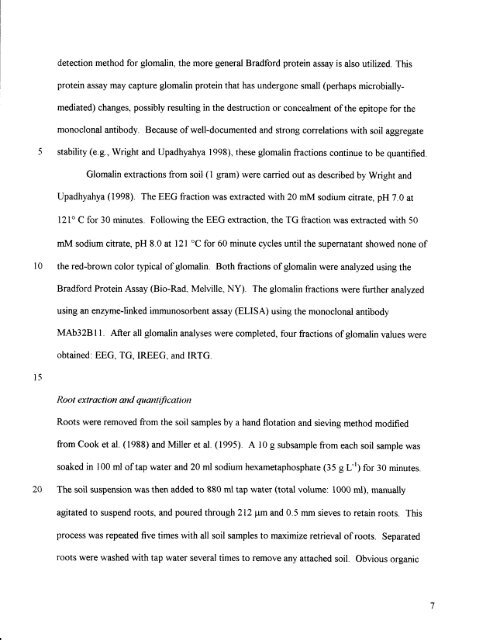Final Report - Center for Invasive Plant Management
Final Report - Center for Invasive Plant Management
Final Report - Center for Invasive Plant Management
Create successful ePaper yourself
Turn your PDF publications into a flip-book with our unique Google optimized e-Paper software.
detection method <strong>for</strong> glomalin, the rnore general Brad<strong>for</strong>d protein assay is also utilized. Thisprotein assay may capture glomalin protein that has undergone small (perhaps microbiallymediated)changes" possibly resulting in the destruction or concealment of the epitope <strong>for</strong> themonoclonal antibody. Because of well-documented and strong correlations with soil aggregatestability (e.g., Wright and Upadhyahya 1998). these glomalin fractions continue to be quantified.Glomalin extractions from soil (1 gram) were carried out as described by Wright andUpadhyahya (1998). The EEG fraction was extracted with 20 mM sodium citrate, pH 7.0 at121o C <strong>for</strong> 30 minutes. Fotlowing the EEG extraction, the TG tiaction was extracted with 50mM sodium citrate, pH 8.0 at l2l nC <strong>for</strong> 60 minute cycles until the supernatant showed none of10the red-brown color typical of glomalin. Both fractions of glomalin were analyzed using theBrad<strong>for</strong>d Protein Assay (Bio-Rad, Melville, NY). The glomalin ttactions were further analyzedusing an enzyme-linked immunosorbent assay (ELISA) using the monoclonal antibodyMAb32Bl1. After all glomalin analyses were completed, four fractions of glomalin values wereobtained: EEG. TG. IREEG. and IRTG.l5Root extracti on and rpt anti fi cal ionRoots were removed from the soil samples by a hand flotation and sieving method modifiedfrom Cook et al. (1988) and Miller et al. (1995). A l0 g subsample fron'r each soil sample wassoaked in 100 ml of tap water and20 ml sodium hexametaphosphate (35 g L-t) <strong>for</strong> 30 minutes.?nThe soil suspension was then added to 880 n{ tap water (total volume: 1000 ml), manuallyagitated to suspend roots, and poured through 212 pm and 0.5 mm sieves to retain roots. Thisprocess was repeated five times with all soil samples to maximize retrieval of roots. Separatedroots were washed with tap water several times to remove any attached soil. Obvious organic
















